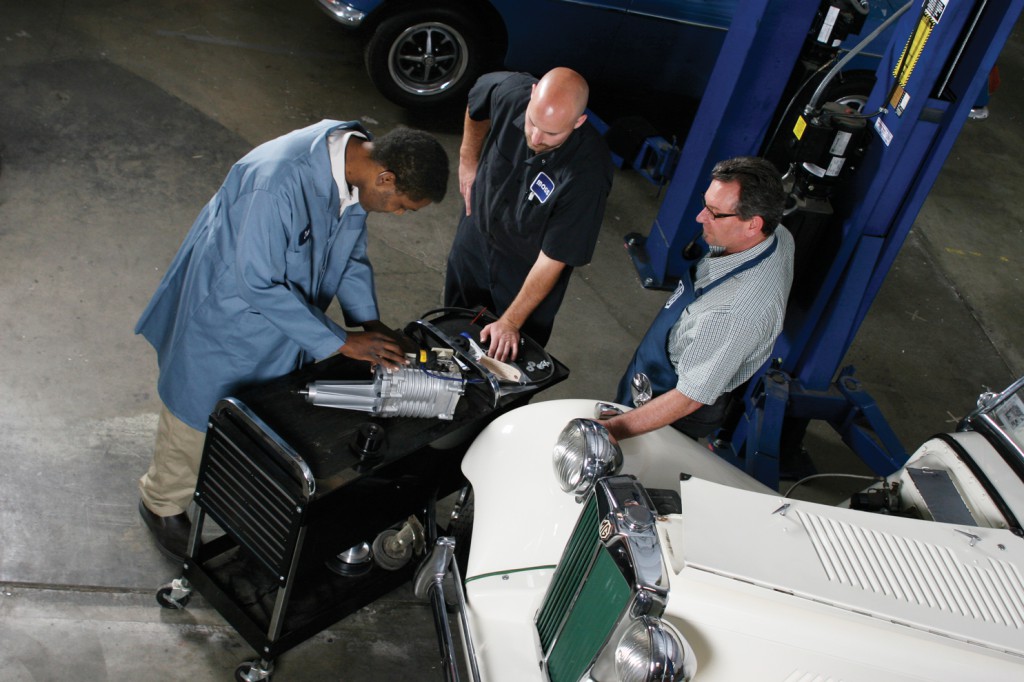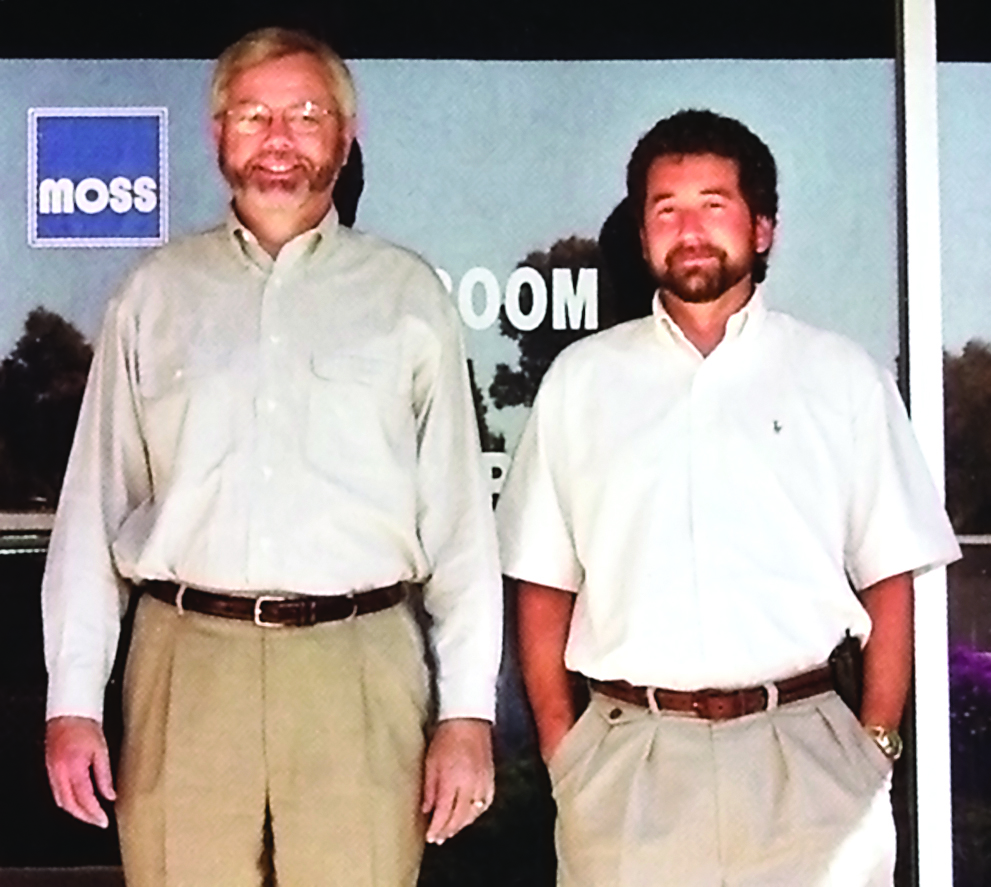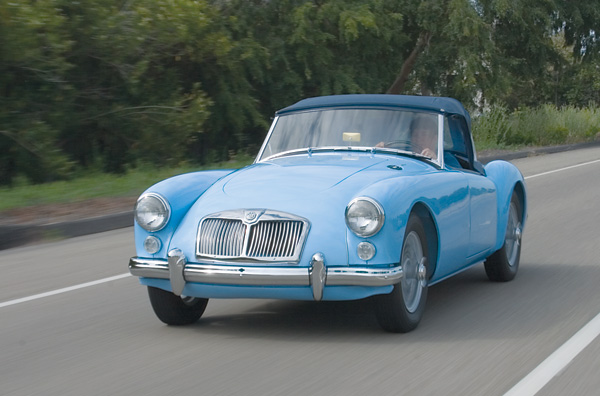In the back of the Moss Motors facility in Goleta, California is a 3,000 sq.ft. research and development shop referred to by staffers as “the toy shop” and “the skunk works.” Only a handful of employees have keys to this secret domain, and access is restricted to the engineers, mechanics, and research staff who are busy dreaming up the next need-to-have performance part or shiny accessory that British car owners long for.

There are more than a dozen employees involved in new product development at Moss, which considers this effort and investment of strategic importance to the company mission. Here automotive design engineer Jason Davis, technician Dave Williams & manager Mark Luis confer on yet another stealth product development project.
This secured area hosts state-of-the-art equipment for testing and tuning, and a fleet of 14 test cars representing the standard British models, plus a few employee cars and customer cars on loan for specific projects. Among the test fleet are five push cars, disassembled and needing a push to move around; a 1980 MGB with only 80 miles used more for reference than testing; and the ultimate mule car, a 1973 MGB. This blue car has been the test bed for more new products than any other – supercharger, air conditioner, big brake kit, sway bars, headlight relay kits, chrome bumper conversion, floorboards, and upholstery kit. “It’s unloved but appreciated,” says Product Development Manager Mark Luis. Many of the test cars appear to have projects in process, with telltale parts nearby, and mechanics and engineers huddled around conferring on performance or measuring fit. Work and discussion always trails off when non-team members get too close. New product development is considered a trade secret until the industry launch. But really, no other parts/accessories supplier serving the British car hobby has the facilities, staff, expertise, or experience to research, develop, and manufacture custom parts at the level Moss Motors does.
Products That Moss Makes
Moss offers over 1,500 products that they have manufactured to their own exacting standards. No one else has these exclusive products, ranging from a simple tool to remove dash switch bezels to superchargers. Whereas so many internet sites simply aggregate related parts and submit purchase orders to vendors, Moss actually orders, quality inspects, and stocks over 30,000 part numbers so they can ensure availability and same day shipping. Increasingly, many of the parts in the massive warehouses on the east and west coasts are Moss exclusives, developed by a multi-faceted in-house product development team. What is Moss making to support and inspire British car owners? They’re the original replacement parts that no one else wants to make any more but are critical to keeping your car on the road. They’re often made by Moss to higher quality standards than original spec. They’re the competitor’s parts that have been outsourced by suppliers and made to poor specifications so they don’t fit right, work right, or last very long, generating owner complaints and requiring Moss to step in to produce quality alternatives. And they’re the parts that enthusiasts and Moss engineers believe would be great improvements over the original design, parts that didn’t exist 50 years ago when these cars were on the road, like air conditioning, fuel injection, and aerospace heat shields.
Trend to “Resto Mods”
“The company got its start with original restoration parts,” says Moss co-owner Robert Goldman, “but there’s a more open attitude now towards modifications that make the car more usable in daily traffic, that enhance the car and the driving experience.” He points to bigger brakes, superchargers, and stainless steel exhaust systems as popular upgrades, known as “resto mods.” Fred Lynch, chief operating officer, says the company intends to lead the hobby with parts emphasizing safety, comfort, convenience, and performance that owners will want as soon as they become available. “The market is shifting to modern components that make these cars more fun and reliable to drive,” he says. Lynch says all ideas are welcome, and end up on the Wish List, a long list of ideas for every car platform. The team meets regularly; production decisions are based on the need in the marketplace, sales estimates, unique features compared to the competition, selling price point, cost to develop and manufacture, tooling investment, minimum order quantity, and return on investment. The decisions are not always about cold-hearted cash, says Luis. For instance, when a brake shoe manufacturer went out of business, Moss had the parts made so owners could continue to drive their cars. And some parts are made as enthusiast inventory, like the new high boost upgrade pulley for supertuning a TR4. Moss also makes upgrade kits for the full line of MG and Triumph superchargers, although sales are relatively small.
The Development Process
No matter if Moss is reproducing an original sample, making product modifications, or creating something new, CAD drawings are produced with technical specifications. Often a rapid prototype is made to test the part design and fitment on the vehicle. When developing a diecast aluminum MGB oil pan, the clear plastic prototype allowed the team to make design adjustments after seeing how the oil moved through the engine, explains Luis. The drawings are then sent out for quotes, and manufacturer samples are tested, fitted, and approved before the final stocking order is placed. The development cycle can range from a few months for something simple to a year and-a-half for the supercharger, which has up to 90 different parts in the kit, says Luis. Over a dozen new projects are in process at all times. Luis is most proud of the MGB supercharger kit, a complex product that results in a 40 percent power increase. But he admits that the fastest selling product in company history was a simple center console organizer for the Mini; he carved the pattern out of foam used for floral arrangements. “When you hit on a need, customers respond,” he says. The dash switch bezel remover was another simple, much-needed item. Since only dealers had the required tool, mechanics and owners have been gashing dashes with screwdrivers for decades when replacing switches.  Retro Goes High Tech Adapting modern technology to cars developed a half-century ago is a challenge, and Moss tries to ensure that upgrades like superchargers and air conditioning don’t require sawing up the car, so an owner can return it to vintage specs down the road, says Luis. “We tried to make the MGB air conditioning look like an original part of the car, not just hung in. It features a modern compressor, condenser, and dryer.” Another challenge is using modern technology but keeping the outside looks period-correct. For instance, the MGB intake manifold looks the same externally, but runs about 10 degrees cooler thanks to internal upgrades that enhance air speed and flow. There’s a voltage regulator under development that looks like the original, but inside the housing is a solid state circuit board. “We’ve got 34 pages of CAD drawings for this small unit, and have spent 150 hours on the drawings alone,” Luis says. Engine cooling takes a cue from racing with updated features on the MGB oil pan – it’s made of die cast aluminum with external fins to dissipate heat better, while inside the baffling prevents oil surges and the windage tray optimizes performance. The aerospace industry inspired new heat shields, with high-tech materials replacing old asbestos. The product cuts passenger compartment noise and heat by 40 percent, says Luis. “Some of those thin floor boards can barbecue your feet.” Sometimes performance part development leads to additional projects, Luis explains. For instance, the added power from the supercharger spawned requests for enhanced brakes, and led to an alternator conversion kit. Shiny accessory parts are also popular, so Moss reprises period accessories like luggage racks made of polished stainless steel with proper fit and finish.
Retro Goes High Tech Adapting modern technology to cars developed a half-century ago is a challenge, and Moss tries to ensure that upgrades like superchargers and air conditioning don’t require sawing up the car, so an owner can return it to vintage specs down the road, says Luis. “We tried to make the MGB air conditioning look like an original part of the car, not just hung in. It features a modern compressor, condenser, and dryer.” Another challenge is using modern technology but keeping the outside looks period-correct. For instance, the MGB intake manifold looks the same externally, but runs about 10 degrees cooler thanks to internal upgrades that enhance air speed and flow. There’s a voltage regulator under development that looks like the original, but inside the housing is a solid state circuit board. “We’ve got 34 pages of CAD drawings for this small unit, and have spent 150 hours on the drawings alone,” Luis says. Engine cooling takes a cue from racing with updated features on the MGB oil pan – it’s made of die cast aluminum with external fins to dissipate heat better, while inside the baffling prevents oil surges and the windage tray optimizes performance. The aerospace industry inspired new heat shields, with high-tech materials replacing old asbestos. The product cuts passenger compartment noise and heat by 40 percent, says Luis. “Some of those thin floor boards can barbecue your feet.” Sometimes performance part development leads to additional projects, Luis explains. For instance, the added power from the supercharger spawned requests for enhanced brakes, and led to an alternator conversion kit. Shiny accessory parts are also popular, so Moss reprises period accessories like luggage racks made of polished stainless steel with proper fit and finish.
The Lock-Up The Lock-Up is like the ancient library of Alexandria – a valuable, irreplaceable reference archive representing the technical knowledge base and history of the British car industry. To a British car owner, it is hallowed ground. This parts Mecca is caged and locked; only three employees have the key. It contains new and used original British car parts, hardware, and accessories, either in original boxes or toe-tagged, and often accompanied by factory blueprints and drawings. Prototypes and first product samples for each Moss-developed part are also stored here. Moss technical experts and new product development team use the rare vintage parts here for reference. For instance, when Moss decided to reproduce a fiberboard glove box that disintegrated when wet in more durable plastic, they referred to the original part in the Lock-Up to get the right texture. “It’s a treasure trove,” says Technical Director Mike Grant, adding that the company is constantly adding to the collection with newly developed parts and accessories.
Necessary Original Parts Original reproduction parts still make up the biggest part of the market, says Shelly Arjomand, corporate purchasing manager. “We aim to keep these cars on the road,” she says, adding that sometimes Moss has to make necessary parts even when they don’t sell many of them. For instance, Moss only sells about eight TR6 fuel lines per year, and the minimum order is a 20-year supply. “We can’t just not carry them,” she adds. Likewise for the MGTD wiper motor, which had been unavailable. Moss reproduces many original parts when there are issues on availability, price, fit, accuracy, or quality. The Global Sourcing team always considers whether an original part can be improved for better fit, finish, or longevity before issuing a production order, says Arjomand. Product team members go to lengths to ensure that vintage replacement parts are exacting to the originals, explains Arjomand. For instance, the only TR6 front spoiler on the market didn’t look anything like the original, so Moss researched and found a new original spoiler to use as a sample, then worked up the CAD drawings and specs, checked the sample fit, and now stocks an accurate reproduction. Only it’s made of more durable High Density Polyethylene for added benefit. In addition, if you need your trucks or vehicles to have upgrades and improvements, for instance, having enough storage capacity for all of your needs, you may consider upgrading your truck parts and Buy Truck Caps.

Moss used to reproduce original equipment, but now the team focuses on how to make the parts better, like making exhaust systems out of stainless steel, and boosting horsepower. Although the supercharger development program took a year-and-a-half from conception to delivery, it has been enthusiastically received by the hobby.
Accuracy Demanded The most extensive effort to ensure accuracy came from Mike Grant, Moss technical director, on the Austin-Healey and Triumph brake reservoirs. Although the factory kept the same part number, they used four different caps and two different decals over the years and did not document when changes were made. By researching old original parts, photographs, and documentation, Grant developed a 12-page flow chart illustrating the brake reservoir caps and decal use by year, month, and VIN number. The document allowed Moss to produce the correct parts that haven’t been available for over 30 years; enabled owners to learn exactly what should be on their cars by posting the research online; and resulted in changes to the concours judging requirements. For the Moss team, it wasn’t enough to simply make the brake reservoir appear correct, they wanted to improve the part’s performance too. What you can’t see inside is a stainless steel washer with integral Viton O-ring, plus an anti-splash rubber seal inside the cap. “If we go to the trouble to make it, the part must be accurate, incorporate better technology, and provide better performance,” says Grant. When possible, Moss offers owners the option of both the original part and an upgraded, modern version. For example, MGB owners can choose the original exhaust from the old patterns, or a polished stainless steel exhaust that fits better and bolts on with hand tools. Moss also offers both original and improved carpet kits for the Austin-Healey 3000. The original carpet had ragged edges and was darted for the dipstick, but the kit changed over time as customers complained that the carpet wore on the dipstick head, explains Grant. Now as the cars are worth more, there were complaints that the carpet kit wasn’t accurate, so Moss re-introduced the cut and sewn as-original kit in addition to the custom deluxe kit with dipstick flap making it easier to check the oil level.
Customer Instructions & Feedback
Moss puts great emphasis on part documentation and installation instructions, says Grant. “If a part is installed wrong, it looks awful or doesn’t work right, the customer has a bad experience, and it’s all our fault.” For instance, Moss doesn’t make top frames, but provides documentation on the various types for the Austin-Healey 3000. “If a customer orders the wrong top for their frame, it fits like socks on a rooster,” he adds. When Moss saw huge return rates on Dunlop wire wheels, the technical experts learned that the wheels can’t be balanced on computer balancing machines. Once they started including directions on how to balance them, returns ended, explains Grant. Even one return or customer complaint can be enough to flag or freeze a product, since Moss takes quality issues seriously, Grant says. Despite many levels of quality control and inspection, there are 30,000 products to track at Moss. For instance, Moss sold 135 sets of billet aluminum door lock knobs ($75) for the Mini without a single return, but when one customer said he destroyed the door lock mechanism trying to get the original plastic knobs off, Moss investigated. The knobs are attached to a wire leading to the locking mechanism in the bottom of the door; the cost to repair the door mechanism was $400. Moss got in touch with buyers who mostly responded that they shelved the product when they couldn’t get the knobs off. The company stopped selling the product, returned the unsold inventory, and sent an unsolicited refund to all 135 customers. Customer feedback helps improve product quality, says Arjomand. Moss sold hundreds of a replacement body panel without a single return, but when one customer said the holes didn’t line up, Moss checked the original body panel only to learn they never fit either. Calls to repair shops confirmed that mechanics were drilling out the holes to adjust. With new design specs, the replacement panels now fit better than the originals. “We’ve all got to work together to come up with products needed and enhance the quality of these cars,” says Arjomand. [important]
Customer Feedback Requested If you’re surprised or disappointed by a part or accessory you ordered through Moss, that’s a problem, says Mike Grant. His department, Technical Services, wants to hear from you so they can make it right, whether the problem is design, manufacturing, installation instructions, or marketing information. If it’s not what you expect, call 800-667-7872
By Kathleen M. Mangan










'Ideas Welcome: Parts Greatly Needed or Entirely Innovative' has no comments
Be the first to comment this post!